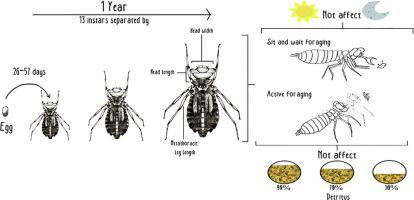Journal of Asia-Pacific Entomology ( IF 1.1 ) Pub Date : 2020-09-02 , DOI: 10.1016/j.aspen.2020.08.014 Fredy Palacino-Rodríguez , Leonardo Rache-Rodríguez , Diego Andrés Palacino , Adolfo Cordero-Rivera

|
Understanding the life cycle of Neotropical odonate species is essential given our scant knowledge of this region. In this paper, we examine growth ratio between instars, development patterns, and active/passive feeding behavior of the Andean dragonfly Erythrodiplax abjecta (Rambur, 1842). Larvae were obtained from eggs laid by two females in the laboratory and were maintained at 12–34 °C in individual containers until either their emergence or their death. Larvae hatched 26–57 days after laying, and the total development time was determined as being 316 (SD ± 6.6) days, including 13 instars. Larval instars were characterized using six morphometric variables. The foraging behavior was analyzed considering the time of day and the percentage of the background covered by detritus. The growth ratios between successive instars averaged 1.9 for FW pad length, 1.6 for HW pad length and 1.2 for head width, head length, metathoracic leg length, and total length. Neither the active foraging nor the sit-and-wait foraging behavior were affected by either time of the day or the percentage of background covered by detritus. Erythrodiplax abjecta is univoltine and has a slow lifestyle associated with lentic perennial waters, where larval development and growth rates are low. We provide an equation to estimate the E. abjecta larval instars from field specimens.
Given that our results were obtained from the eggs laid by only two females, further studies including a larger sample size are needed to validate their generality.
中文翻译:

圈养红斑蚁(Rambur)(无翅目:Libellulidae)的幼体发育和觅食行为
鉴于我们对这一地区的了解不足,因此了解新热带齿质的生命周期至关重要。在本文中,我们研究了安第斯蜻蜓Erythrodiplax abjecta的幼虫生长率,发育模式和主动/被动摄食行为(拉姆伯,1842年)。幼虫是从实验室中两名雌性产下的卵中获得的,并保持在12–34°C的单独容器中,直到它们出现或死亡。幼虫在产卵后26-57天孵出,总发育时间确定为316(SD±6.6)天,包括13龄。幼虫龄期使用六个形态计量学变量进行表征。考虑一天中的时间和碎屑覆盖的背景百分比,分析了觅食行为。连续的幼虫之间的生长率平均为FW垫长度为1.9,HW垫长度为1.6,头部宽度,头部长度,后胸腿长度和总长度平均为1.2。主动觅食和静坐觅食行为都不受一天中的时间或碎屑覆盖的背景百分比的影响。Erythrodiplax abjecta是单伏性的,生活方式缓慢,与多年生的扁豆体水有关,那里的幼体发育和生长率低。我们提供了一个方程,可以从田间标本中估算出本草的幼虫龄期。
鉴于我们的结果是从只有两个雌性产下的卵中获得的,因此需要进一步的研究,包括更大的样本量,以验证其普遍性。











































 京公网安备 11010802027423号
京公网安备 11010802027423号